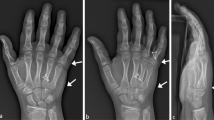Abstract
Objective
To investigate the diagnostic accuracy and time in the detection of fractures on pediatric foot radiographs marked without and with localization cues.
Method
One-hundred randomly selected foot radiographic examinations that were performed on children (<18 years old) after injury and with at least 4 weeks of follow-up were included. Blinded to history and diagnosis, 4 readers (one each: medical student, pediatrician, pediatric orthopedic surgeon, and pediatric musculoskeletal radiologist) retrospectively and independently reviewed each examination twice (without and with cue, at least 1 month apart, and after randomization). Each reader recorded the presence or absence of a fracture, fracture location, diagnostic confidence, and the total (interpretation) time spent on each study. Diagnostic accuracy, reader confidence, and interpretation time were compared between examinations without and with cues.
Results
Our study included 59 examinations without and 41 with fractures (21 phalangeal, 18 metatarsal, and 2 tarsal fractures). Localization cues improved inter-reader agreement (κ=0.36 to 0.64), overall sensitivity (68 to 72%), specificity (66 to 73%), and diagnostic accuracy (67 to 73%); thus, overcalled and missed rates also improved from 34 to 27% and 32 to 28%, respectively. Reader confidence improved with cue (49 to 61%, p<0.01) with higher incremental improvement with younger children (30% for 1–6 years; 14% for 7–11 years; and 10% for 12–17 years). Interpretation time decreased by 40% per examination (40±22 s without to 24±13 s with cues, p<0.001).
Conclusion
Localization cues improved diagnostic accuracy and reader confidence, reducing interpretation time in the detection of pediatric foot fractures.




Similar content being viewed by others
References
Lambers K, Ootes D, Ring D. Incidence of patients with lower extremity injuries presenting to US emergency departments by anatomic region, disease category, and age. Clin Orthop Relat Res. 2012;470(1):284–90.
Cooper C, Dennison EM, Leufkens HG, Bishop N, van Staa TP. Epidemiology of childhood fractures in Britain: a study using the general practice research database. J Bone Miner Res Off J Am Soc Bone Miner Res. 2004;19(12):1976–81.
Chaturvedi A, Mann L, Cain U, Chaturvedi A, Klionsky NB. Acute fractures and dislocations of the ankle and foot in children. Radiographics: a review publication of the Radiological Society of North America, Inc. 2020;40(3):754–74.
Denning JR. Complications of pediatric foot and ankle fractures. The Orthopedic clinics of North America. 2017;48(1):59–70.
Kay RM, Tang CW. Pediatric foot fractures: evaluation and treatment. J Am Acad Orthop Surg. 2001;9(5):308–19.
Biber R, Gregory A. Overuse injuries in youth sports: is there such a thing as too much sports? Pediatr Ann. 2010;39(5):286–92.
Fernandez WG, Yard EE, Comstock RD. Epidemiology of lower extremity injuries among U.S. high school athletes. Academic emergency medicine : official journal of the Society for. Acad Emerg Med. 2007;14(7):641–5.
Gottschalk AW, Andrish JT. Epidemiology of sports injury in pediatric athletes. Sports Med Arthrosc Rev. 2011;19(1):2–6.
Wei CJ, Tsai WC, Tiu CM, Wu HT, Chiou HJ, Chang CY. Systematic analysis of missed extremity fractures in emergency radiology. Acta Radiol. 2006;47(7):710–7.
Mounts J, Clingenpeel J, McGuire E, Byers E, Kireeva Y. Most frequently missed fractures in the emergency department. Clin Pediatr. 2011;50(3):183–6.
Sarwar A, Wu JS, Kung J, Brook A, Lee KS, Gauguet JM, et al. Graphic representation of clinical symptoms: a tool for improving detection of subtle fractures on foot radiographs. AJR Am J Roentgenol. 2014;203(4):W429–33.
Kim YW, Mansfield LT. Fool me twice: delayed diagnoses in radiology with emphasis on perpetuated errors. AJR Am J Roentgenol. 2014;202(3):465–70.
Jensen I, Wester JU, Rasmussen F, Lindequist S, Schantz K. Prognosis of fracture of the talus in children. 21 (7-34)-year follow-up of 14 cases. Acta Orthop Scand. 1994;65(4):398–400.
Ribbans WJ, Natarajan R, Alavala S. Pediatric foot fractures. Clin Orthop Relat Res. 2005;432:107–15.
Al-Sani F, Prasad S, Panwar J, Stimec J, Khosroawshahi A, Mizzi T, et al. Adverse events from emergency physician pediatric extremity radiograph interpretations: a prospective cohort study. Acad Emerg Med Off J Soc Acad Emerg Med. 2020;27(2):128–38.
George MP, Bixby S. Frequently missed fractures in pediatric trauma: a pictorial review of plain film radiography. Radiol Clin N Am. 2019;57(4):843–55.
Berbaum KS, Franken EA Jr, Dorfman DD, Barloon TJ. Influence of clinical history upon detection of nodules and other lesions. Investig Radiol. 1988;23(1):48–55.
Berbaum KS, Franken EA Jr, el-Khoury GY. Impact of clinical history on radiographic detection of fractures: a comparison of radiologists and orthopedists. AJR Am J Roentgenol. 1989;153(6):1221–4.
Rickett AB, Finlay DB, Jagger C. The importance of clinical details when reporting accident and emergency radiographs. Injury. 1992;23(7):458–60.
Patel V, Gendler L, Barakat J, Lim R, Guariento A, Chang B, et al. Pediatric hand fractures detection on radiographs: do localization cues improve diagnostic performance? Skelet Radiol. 2023;52(2):167–74.
Landis JR, Koch GG. The measurement of observer agreement for categorical data. Biometrics. 1977;33(1):159–74.
Owen RJ, Hickey FG, Finlay DB. A study of metatarsal fractures in children. Injury. 1995;26(8):537–8.
Itri JN, Tappouni RR, McEachern RO, Pesch AJ, Patel SH. Fundamentals of diagnostic error in imaging. Radiographics: a review publication of the Radiological Society of North America, Inc. 2018;38(6):1845–65.
Castillo C, Steffens T, Sim L, Caffery L. The effect of clinical information on radiology reporting: a systematic review. J Med Radiat Sci. 2021;68(1):60–74.
Author information
Authors and Affiliations
Corresponding author
Ethics declarations
Conflict of interest
The authors declare no competing interests.
Additional information
Publisher’s note
Springer Nature remains neutral with regard to jurisdictional claims in published maps and institutional affiliations.
Rights and permissions
Springer Nature or its licensor (e.g. a society or other partner) holds exclusive rights to this article under a publishing agreement with the author(s) or other rightsholder(s); author self-archiving of the accepted manuscript version of this article is solely governed by the terms of such publishing agreement and applicable law.
About this article
Cite this article
Patel, V., Tariq, S.M., Hong, S. et al. Identification of fractures on pediatric foot radiographs: do localization cues improve diagnostic accuracy and reduce interpretation time?. Skeletal Radiol 53, 345–352 (2024). https://doi.org/10.1007/s00256-023-04401-9
Received:
Revised:
Accepted:
Published:
Issue Date:
DOI: https://doi.org/10.1007/s00256-023-04401-9




